Spitfire F Mk.IX
Profipack Edition
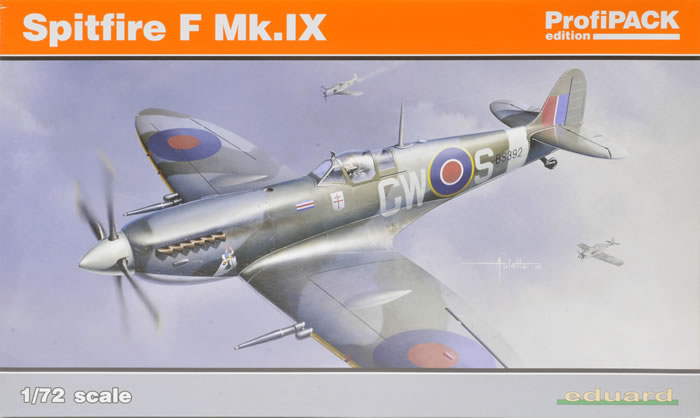
Eduard, 1/72 scale
S u m m a r y : |
Catalogue Number: |
Eduard Kit No. 70122 - Spitfire F Mk.IX Profipack Edition |
Scale: |
1/72 |
Contents & Media |
91 grey and seven clear styrene parts, one coloured PE fret with 28 parts, a pre-cut Kabuki tape canopy mask, and decals for four markings options. |
Price: |
Available on-line from these stockists:
Click for currency conversion. |
Review Type: |
First Look. |
Advantages: |
The best 1/72 Spitfire Mk.IX; very accurate, great detail, good options, and terrific value. |
Disadvantages: |
None noted. |
Conclusions: |
Eduard’s Spitfire Mk.IX is the best in “The One True Scale” by a long measure, and is a superb example of the kit maker’s art. I think it represents great value and cannot recommend it highly enough. |
Reviewed by
Mark Davies

Eduard’s 1/72 Spitfire F Mk.IX Profipack Edition is available online from Squadron.com
In the early months of 1942, with the clear superiority of the Focke Wulf Fw 190 over the Spitfire VB, there was much pressure to get Spitfires into production using the new two-stage supercharged Merlin 61 engine. In September 1941 the Spitfire Mk III prototype N3297 had been converted by Rolls-Royce at their Hucknall plant to take a Merlin 60, which had been specifically designed for use in the Wellington Mk VI high altitude bomber.
The performance increase was described by Jeffrey Quill as a "quantum leap" over that of the Mk VB and another Spitfire airframe, R6700 was modified to take the new engine. Although design work on the Mk VII and VIII series was under way, these would take over a year to get into production and a counter to the Fw 190 was urgently needed.
The Air Ministry made the decision that Mk VC airframes should be converted to take the more powerful engine and, as a result, many of the early IXs were converted Mk VCs which did not have any of the refinements which later appeared. These could be identified by the Type C wing with the large double blisters over the inner cannon bays and the identification light on the fuselage spine, behind the aerial mast. The elevator horns were also smaller in size than that of most Mk IXs which had larger horn balances. The first IX was a modified VC AB505, which was tested by the Air Fighting Development Unit (AFDU) in April 1942. The report said;
The performance of the Spitfire IX is outstandingly better than the Spitfire V especially at heights above 20,000 feet. On the level the Spitfire is considerably faster and climb is exceptionally good. It will climb easily to 38,000 feet and when levelled off there can be made to climb in stages to above 40,000 feet by building up speed on the level and a slight zoom. Its manoeuvrability is as good as a Spitfire V up to 30,000 feet and above is very much better. At 38,000 feet it is capable of a true speed of 368mph and is still able to manoeuvre well for fighting.
Although the Mk IX's airframe did not have the aerodynamic and strength improvements, or the modified control surfaces of the Mk VII and VIII, the Mk IX still proved to be an effective counter to the Focke Wulf Fw 190.
Source: Wikipedia
Previous 1/72-scale Spitfire Mk.IX Kits
I will include Mk.XVIs as externally they are identical to Mk.IXs with the same wing type.
There has been quite been a lot of 1/72 Spitfire Mk.IX kits over the years with just a few boxed as Mk.XVIs. Only Heller, CMR and Sword have offered low-backs. All are injected kits unless otherwise noted. I will ignore the very few TR.9 and other two-seat Mk.IX kits and focus on single-seaters.
The first was by Airfix in 1960 or possibly Lindberg (1/75-scale), followed in no particular order by Frog (re-boxed by Intech), Cruver, Lotnia, LB Models (resin), Matchbox, KP (re-boxed by Mastercraft Models), Esoteric (resin), Ventura, Heller (low-back), Hasegawa, Italeri, and CMR (resin with various high and low-back boxings). I have also read of the existence of a Mk.IX by Monogram, but have no other information about it. More recently, there have been new releases by Airfix, Sword and AZ Model. I felt that the Airfix kit was a disappointment with too many faults, whilst the Sword and AZ Model kits both offered excellent kits in both high and low-back versions.
For as long time I considered CMR’s kits to be the best overall because of their accuracy, options and attention to detail, followed by the Sword and AZ Model injected kits, which leave little to choose between them, although I personally favour AZ slightly. But as anyone who has read reviews of the new Eduard Mk.IX kits* already knows, all previous kits have now been thoroughly bettered (I was going write “trumped” but thought better of it!).
*The one exception is CMR’s unique Mk.IX Rolls Royce conversion that features the hand beaten cowls fitted to the very first converted Mk.Vs that were distinctly different to production line Mk.IX’s and Mk.V conversions.
The Contents
The parts come in a top-opening box and are enclosed in re-sealable cellophane bags, with the clear sprue, PE fret, canopy mask and decals each in their own separate bags.
The instruction booklet is printed in colour on glossy paper, with clear and easy to follow drawings. These can be viewed or downloaded from Eduard’s website by clicking here. Colour call-outs are cross referenced to Gunze Sangyo’s Aqueous and Mr. Color paint ranges, and include RAF names for the camouflage colours.
This boxing and its markings represent early Mk.IXs that retained many Mk.Vc airframe features. However, also included are parts applicable to later Mk.IXs, the Mk.XVI, Mk.VII and VIII. These are surplus to requirements as the parts map indicates:
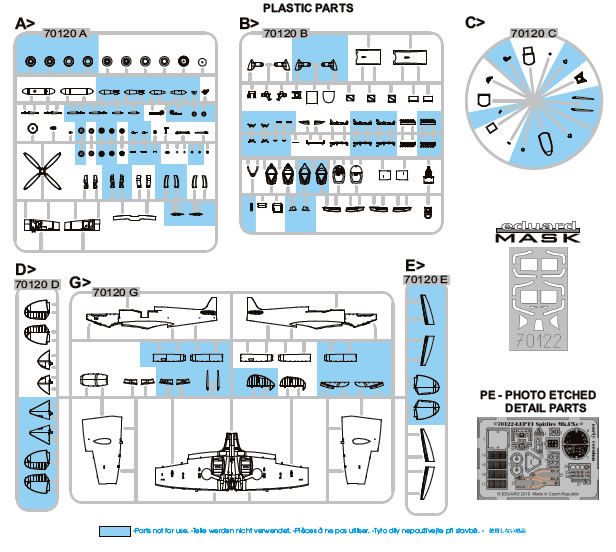
The moulding of the five grey airframe sprues is flawless, with super-crisp and delicate detail, narrow sprue gates, and thoughtfully positioned ejector pins. The clear parts are likewise flawless, thin and clear; whilst the PE fret and paint-mask are also produced to Eduard’s usual high standards.
The Kit
The first thing that struck me was the delectable surface detail this kit exhibits. It has ultra-fine and consistent recessed panel lines, and has some of the best rivet detail I have encountered in the scale. Rivets have come back into modelling fashion, but unlike many brands following this trend, Eduard has managed to keep theirs unobtrusive and in the right places.
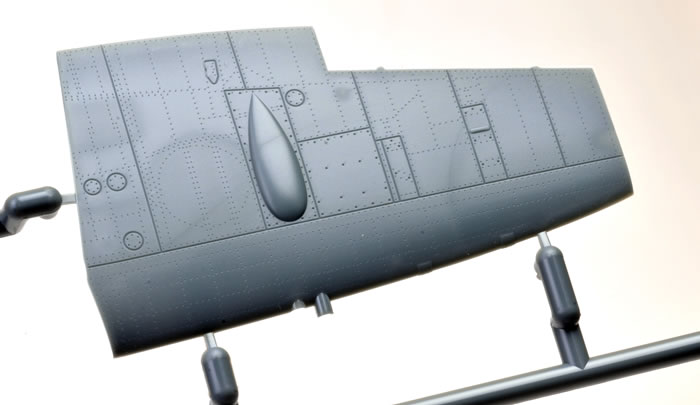
The accompanying parts images tend to emphasise them due to the bright lighting used, whereas under normal lighting all but disappear depending on the angle the parts are viewed from. Where applicable, the fabric control surfaces are correctly portrayed as being drum-tight, with rib-tapes that again appear more prominent in the images than they actually are.
There is not a lot of room in a Spitfire’s cockpit in this scale, but Eduard has made a very nice job of things. They have adopted a slightly unusual approach for 1/72 scale spitfires by moulding the sidewall detail below the level of the pilot’s door on separate inserts, as opposed to integrally with the fuselage halves. This makes sense as it matches the method used for Eduard’s Brassin resin and PE cockpit set sold separately; making the kit and Brassin parts readily interchangeable.
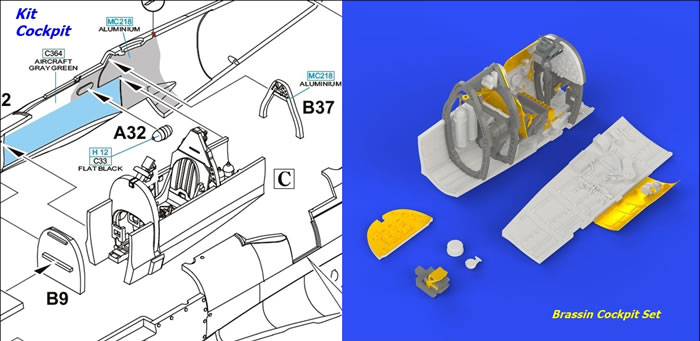
Coloured PE garnishes the seat with a coloured PE harness, and also replaces the moulded compass repeater below the instrument panel. There is choice of instrument panels; one has raised detail and optional instrument decals, and the other is smooth to accept the very nice coloured PE instrument detail.
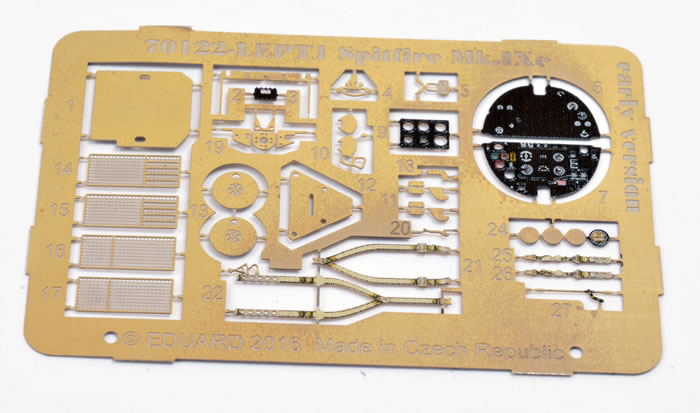
There is a choice of fuselage frame behind the pilot’s seat. One option requires the addition of PE head armour, whilst the other has the armour moulded in place and requires the tiny slot for the harness to be opened up. The frame with the amour moulded in place is obviously suited to a pending Weekend Edition that will lack a PE armour option, but why it is included as an option in the Profipack Edition’s instructions is unclear to me. Both frames mount the characteristic voltage regulator behind the armour that was a carry-over feature from the Mk.V.
Various other PE parts all add to the high detail levels moulded detail provided; some are quite small, such as the brake lever that fits to the control column handgrip. There is also a gun-sight is moulded in clear.
The canopy is nice and clear with the optional parts for open or closed presentation. There are three pilot’s entry doors, two providing open or closed options to be used in conjunction with an open canopy, and another closed one to be used with the closed canopy.
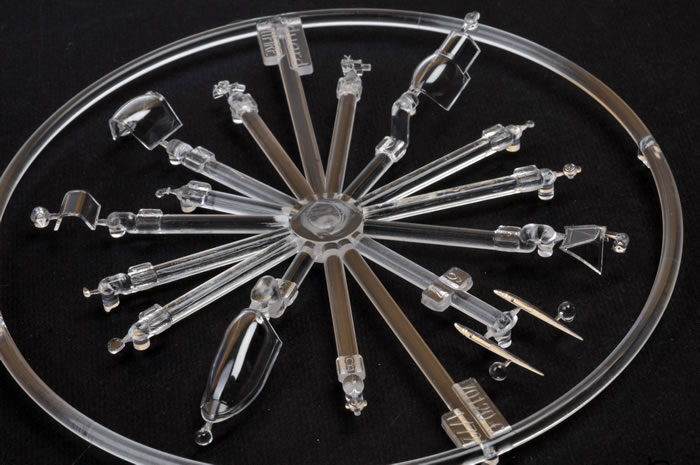
A closed canopy requires a small section of canopy rail to be removed from each fuselage half in order for the closed canopy to fit properly. Care will be needed when removing these quite small areas, but it has enabled Eduard to provide a very realistic appearance to the canopy rails with either open or closed canopies.
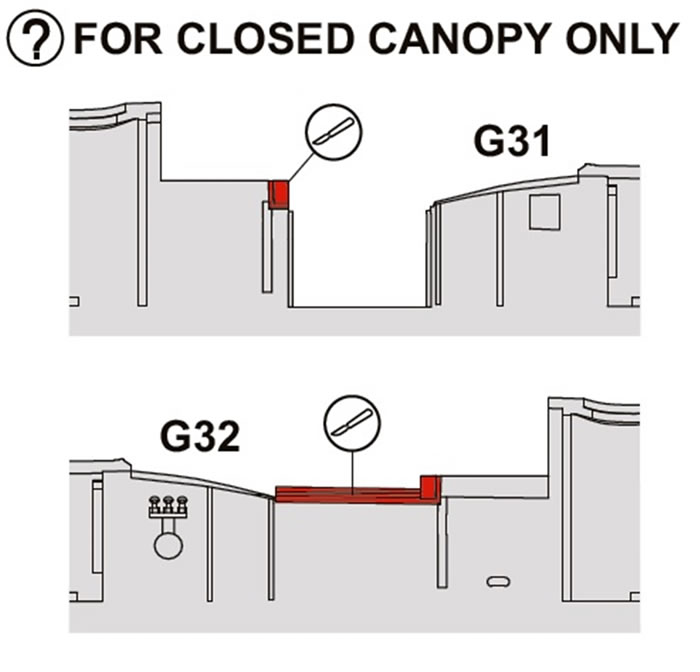
Internal and external rear-view mirrors to mount on the windscreen are included as PE parts. A pre-cut canopy mask is included, this being a Profipack Edition.
The fuselage halves enclose the cockpit assembly, and have separate upper and lower cowl parts, as well as separate forward wing-roots. This added complexity is to accommodate variations across other boxings that include three styles of upper cowl, two lower cowls with early and late style carburettor intakes; whilst the two wing-root styles allow for the later port to starboard switch of the gun camera, made necessary by the incorporation of a fuel-cooler to cure vapour locks. The kit includes additional internal support in the nose area of the fuselage halves to ensure that good fit is not compromised by the multi-version/multi-part approach adopted. As per the original, there is a small brace to fit between the frame carrying pilot’s head armour and the fuselage frame at the rearmost part of the canopy.
The instructions advise to drill through two blind holes just ahead and below the forward exhaust stub on this starboard side. This is to help locate a small bulge identical to the Coffman Starter bulge found on the Mk.II. However, in this case the bulge covered a cockpit pressurisation drive associated with the Merlin 61 and 63* engines fitted to early Mk.IXs, despite them not having pressurised cockpits. The same bulge can be on the Spitfire Mk.VI, VII & VIII, but is absent from later Merlin 66 powered Mk.IX’s and Packard Merlin Mk.XVIs.
*The Merlin 63A did not have a pressurisation drive, but shared its crankcase with the Merlin 64 that did, and so the bulge is present in Merlin 63A powered aircraft to provide clearance.
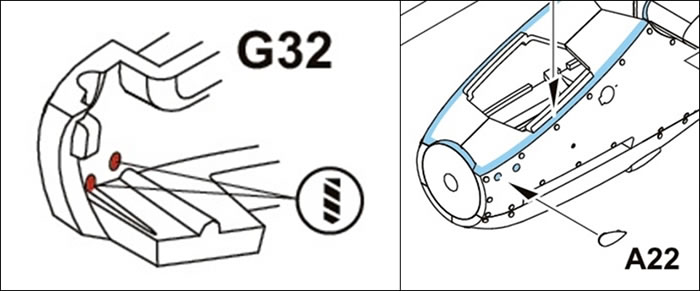
The wings are split between their upper and lower surfaces as you would expect. The upper surfaces with this boxing feature the large bulge over both cannon bays, as found on the Mk.Vc. Sandwiched between the wing halves are a portion of main spar and undercarriage bay walls. The wingtips are separate in keeping with the need to offer three tip styles across multiple versions in other boxings; likewise, the early rounded and pointed rudders are separate parts, with the rounded style applying to the review kit. The early and late style ailerons are also separate from the wings, whereas the elevators are fixed to the horizontal stabilizers; although three types of tailplane are supplied with early small-horn balance fabric elevators applicable to the review kit, and the large-horn style with either fabric or metal skins being surplus.
Eduard has adopted an unusual (for this scale at least) multipart approach to the radiator/intercooler housings. The sides are separate from the bottom panel, which has enabled detail to be moulded on both sides, which is a real plus if the separate vent panels are positioned fully lowered. The radiator/intercooler matrix is moulded with the lower wing sitting inside well represented ducting. The matrix faces are supplied as PE parts (I suspect that these will be supplied as decals in Weekend Editions).
The mouth of starboard radiator housing has a small PE pipe representing the end of the fuselage fuel tank vent pipe. It runs from the wing underside into the face of the coolant radiator’s matrix* (see photo below for the real thing). Some may prefer to replace the kit’s PE part with lead wire to give a more authentic appearance.
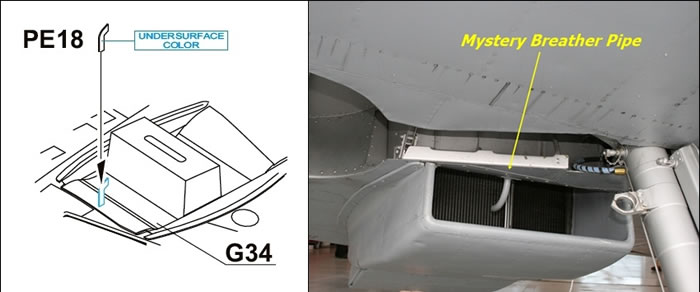
* In service the Spitfire’s fuel tanks were pressurised with regulated vacuum pump exhaust air to prevent the fuel in the tanks from boiling and vaporising at high altitudes. If the fuselage fuel tanks got punctured continued pressurisation was not recommended as this would work against the self sealing compound trying to seal the leaks; so the pilot would change from pressure venting to normal venting by switching a cock in the cockpit, which then redirected the vacuum exhaust air vent to the atmosphere. The outlet for this redirected vacuum exhaust air is that little vent pipe at the front of the starboard radiator. Most restored Spitfires have the pressure venting cock locked in the "normal venting" position as pressurising of the fuel tanks is not necessary.
The instructions advise which of three styles of main undercarriage leg supplied is to be used; along with five-spoke main wheels (surplus three and four-spoke are also included) are split between the spoked face and brake drum. One markings option requires the fitting of solid PE wheel rims over the top of the five-spokers. The tyres are split, presumably to reduce the risk of sink-marks, and once assembled can have the wheel rims fitted after painting. The tail-wheel and its leg is a simple on-piece item, as expected.
Three styles of external fuel tank are included with this boxing; a cigar-style with rack and PE sway braces, and two sizes of slipper tank (60 & 90 Gallon) with PE locating hooks.
Not much remains to mention assembly-wise. There are the fish-tail exhausts that can be fitted after painting is complete, the cannons and domed blanking caps, underwing pitot, fuselage fuel-tank filler cap, a very refined four-blade prop with separate spinner, antenna mast with separate base, and clear teardrop dorsal light.
Of course, Eduard specialises in aftermarket details and accessories; and in the case of the Spitfire Mk.IX there are numerous sets well worth checking out at Eduard’s website.
Colours & Markings
The decals provide for four markings options, along with quite extensive stencilling.
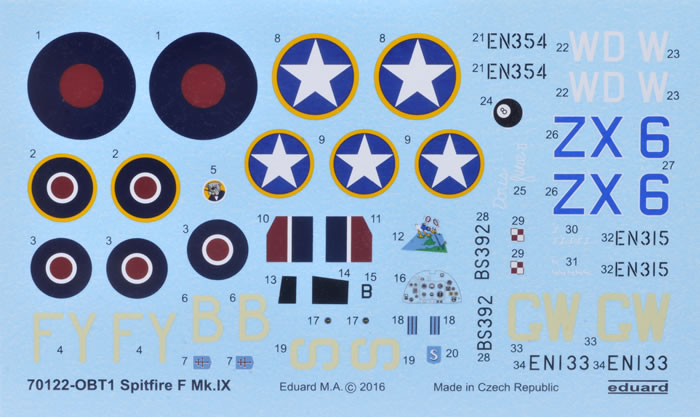
Each scheme is illustrated in colour with a single page of four-view drawings, whilst the stencil locations are identified in a separate page of their own.
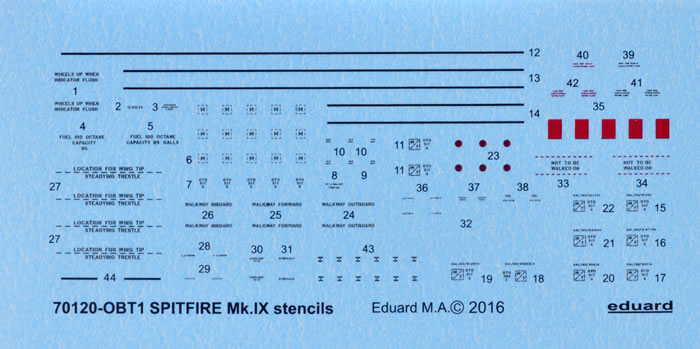
The machines covered are those of:
- BS392 / CW-S, Sqn Ldr Bernard Duperier, OC No 340 Squadron, Biggin Hill Airbase, Autumn 1942;
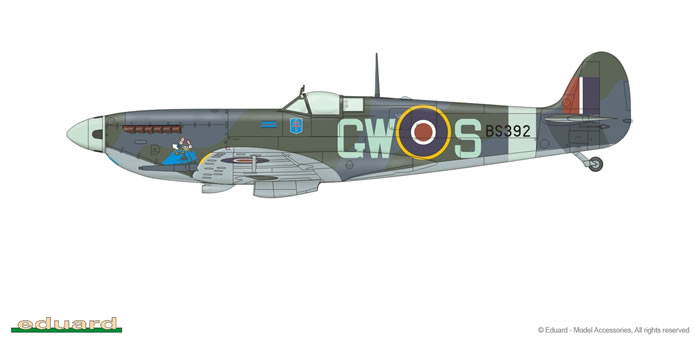
- EN315 / ZX-6, Sqn Ldr Stanislav Shalski, Polish Combat Team, North Africa, spring 1943;
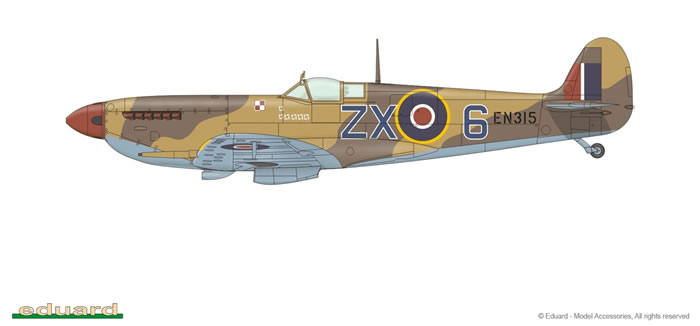
- EN133 /FY-B, No 611 Squadron, Biggin Hill Airbase, early 1943; and
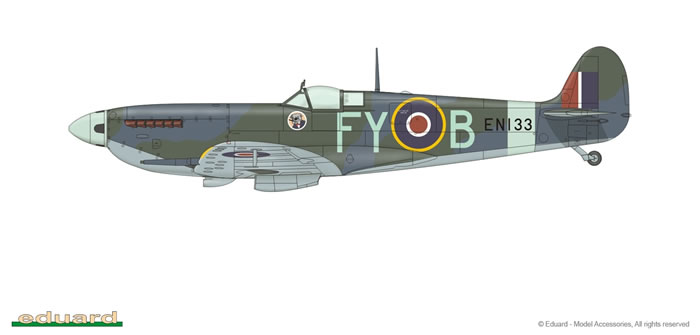
- EN354 / WD-W, 1st Lt Leonard V. Helton, 52nd FG, 4th FS, La Sabala Airfield, Tunisia, June 1943.
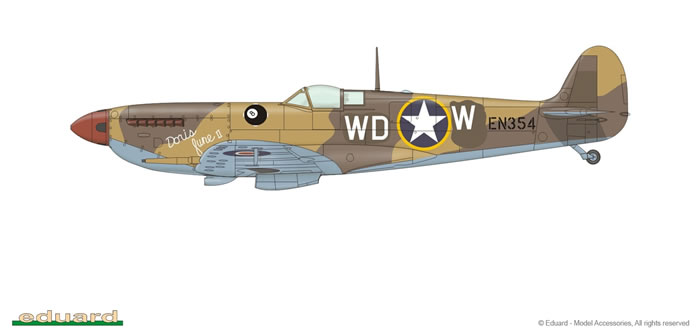
The decals appear to be of excellent quality, with crisp registration and good colouration.
Eduard’s Spitfire Mk.IX is the best in “The One True Scale” by a long measure, and is a superb example of the kit maker’s art. I think it represents great value and cannot recommend it highly enough.
Thanks to Eduard for the sample
Review Text and Images Copyright © 2017 by Mark Davies
Sprue Photos Copyright © 2017 by Brett Green
Page Created 8 March, 2017
Last updated
8 March, 2017
Back to HyperScale Main Page
Back to Reviews Page |
